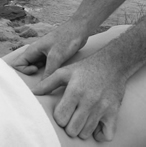Physical, Emotional & Mental Healing…
Physical, Emotional & Mental Healing… Experiencing Structural Integration
Structural Integration (SI) is a form of deep tissue bodywork that incorporates movement and posture education. Joy K. came to me for SI sessions about a year ago. Having already received a series of ten sessions, she was ready for advanced work on a physical and emotional level. She takes a very active role in her healing process and is open to the journey of self-discovery that SI provides. This makes her an ideal client; she is self-motivated, aware, and communicative of her process.
 Vision Magazine: What prompted you to seek out Structural Integration?
Vision Magazine: What prompted you to seek out Structural Integration?
Joy K: I sought out SI because I was in a lot of pain and nothing else, including physical therapy, personal training, or massage, seemed to be working.
VM: What benefits have you received from Structural Integration?
JK: The benefits I’ve received from SI are really physical, emotional and mental. Primarily, it helped me process emotions that had been trapped in my body. It eased my pain tremendously and I was able to resume the active life that I enjoy.
VM: What kind of pain where you having and what kind of relief have you experienced?
JK: I had a lot of injuries from doing Kenpo karate. I also fell very hard on my sacrum. My quadratus lumborum was screwed up and I had tendonitis/bursitis in my shoulder. My pain on a scale from one to ten was probably an eight on a daily basis and it was really hard to function. The work helped my muscles be where they’re supposed to be, the sheath on top of those muscles relaxed, and my body was able to heal itself.
VM: Has SI affected your range of motion or flexibility in any way?
JK: My range of motion is a lot better and my movements seem more fluid. The stiffness in my joints has lessened, as well. I can now move around a lot easier, probably better than I did in my 20s.
VM: How would you describe your response to your first SI session?
JK: After my first visit, I felt like I had taken a muscle relaxer and I couldn’t move. I had to park somewhere for about 30 minutes, and it freaked me out a little bit. Sometimes I would wake up in the middle of the night and feel my muscles moving back into place or something. It was really weird. The first thing I noticed was that my diaphragm was freeing up and I was able to take a deep breath again. I don’t think I’d been able to take a deep breath since I was a child.
VM: Here is the question people wonder about SI: is it painful?
JK: It’s relative. I can handle a lot of pain, but SI is what I would classify as “good pain,” especially if you breathe through it—the breath is very important. The way I know the difference between good pain and bad pain is this: good pain is releasing something and it feels like the kind of pain that the body craves. If I just breathe through it, it subsides very quickly. Bad pain is sharper and radiates a little more. During the fourth session, I had to ask the practitioner to pull back because the pain was too close to the edge. The mark of a good practitioner is that he or she will work with you to determine where your boundaries are. It’s up to the client to let the practitioner know where the pain threshold is.
VM: In SI, the focus is on building more awareness in the body. How has this expanded consciousness changed your relationship with your physical self?
JK: It’s forced me to really be in my body. I have a lot of body image and eating disorder issues, along with a history of body dysmorphia and dissociation from my body. This is why I’ve experienced physical problems: because I’ve ignored my body’s cries for help. I listen to my body a lot more now and I let it tell me what it needs and what it wants—not just through activity but through all of the other sensations I have. It’s been extremely beneficial for me to feel safe in my body and take good care of myself, because this is the only body I will ever have.
VM: Do you feel your posture and movement has improved as a result of SI?
JK: It’s 100 percent better. People give me compliments all the time on my posture. Six years ago, I had horrible posture and I was in a ton of pain. I couldn’t force myself to have good posture when I tried. It made me feel really good to have people compliment me again and again on how good my posture is. But more importantly, it’s just easier to move in the world. It’s easier to sit up and I don’t have back problems like I used to. There’s no other way I could have gotten there without investing in myself and getting this work done.
VM: What advice would you give to people seeking wellness in their lives?
JK: I always encourage people to give to themselves. Health is not just about physical wellness. Some people may not be open to exploring mental and emotional parts of their being, but it’s beneficial on many levels. It’s a huge investment you make in yourself and your health. You maintain your car and you maintain your house, but you’ve got to maintain your body—you can’t neglect it or ignore it.
Archie Underwood, BA, HHP, practices Structural Integration in San Diego, CA. You can reach him at 619.861.3232 or visit www.rolfsi.com.

